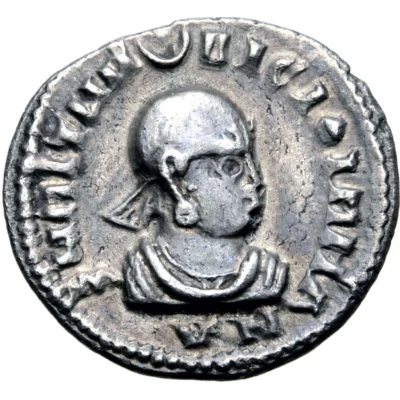


© The Heberden Coin Room, Ashmolean Museum, University of Oxford
½ AR Unit - Aphilas
| Gold (.800) plated silver (.650) (Selective gilt) | 0.98 g | 13.00 mm |
| Issuer | Aksum |
|---|---|
| King | Aphilas (circa 305-315) |
| Type | Standard circulation coin |
| Years | 305-315 |
| Composition | Gold (.800) plated silver (.650) (Selective gilt) |
| Weight | 0.98 g |
| Diameter | 13.00 mm |
| Thickness | 2.00 mm |
| Shape | Round (irregular) |
| Technique | Hammered |
| Orientation | Medal alignment ↑↑ |
| Demonetized | Yes |
| Updated | 2024-10-09 |
| Numista | N#311419 |
|---|---|
| Rarity index | 94% |
Reverse
Small bust of Aphilas to right, wearing headcloth ornamented on front and ending with triangular ribbon behind, within a hollow gilt circle; above, pellet on crescent dividing lettering.
Border of dots.
Script: Greek
Lettering: ΑΦΙΛΑC ΒΑCΙΛΑЄΥCΙ
Unabridged legend: Αφιλας βασιλεύςι
Translation: King Aphilas
Comment
This type is currently known as the first of the Aksumite coinage to feature gilt.The reverse lettering is interpreted differently because of the presence of a final letter I:
- Munro-Hay used this letter as the starting point of the reverse legend, rendering the name as Iaphilas rather than Aphilas. However he did not provide a proper explanation to this choice nor to its potential interpretation.
- Anzani, using the same lettering base, suggested that it could refer to a son of Aphilas thus named Iaphilas. He also linked this theory with the size of the portrait on reverse as being smaller to indicate not the main ruler but a less important reigning figure.
- Hahn rather used this letter I as the ending point of the legend. He put forward two theories:
- The first one mentioning that the legend uses a dative form that could be translated as "for the kings", suggesting this type would refer to a co-ruling period of Aphilas and Ousanas.
- The second one proposed the I would not be a letter but a simple legend separator. This cannot be discarded for sure as Aphilas' coinage features various experiments compared to the coinage of Endubis and of his successors; however, it seems highly unlikely, given no real separator is used across Aksumite coinage besides the classic pellet on crescent.
Minor variations in the details of the obverse and reverse portraits are known, especially concerning the drapes or the width of the busts.
The type SACAM# 37 (HCR# 54127) features a minor lettering variation on obverse with the second letter A being replaced by the letter Δ.
© Roma Numismatics Limited
Weight variation: 0.62-1.03 g.
Diameter variation: 11.50-13.00 mm.
Interesting fact
One interesting fact about the Aksumite coin is that it features a unique blend of materials and techniques. The coin is made of gold (.800) plated silver (.650), with selective gilt, which means that only certain parts of the coin have been coated with a thin layer of gold. This combination of materials and techniques was used to create a coin that was both durable and aesthetically pleasing.

